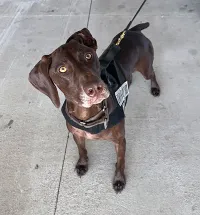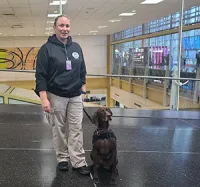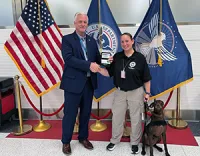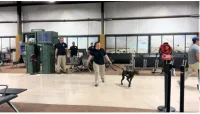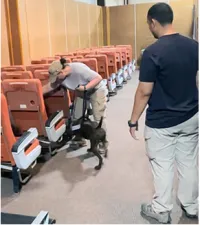
A new canine team is on the job at one of the nation’s largest airports, and we’re giving you a sneak peek, behind-the-scenes glimpse of their months-long journey.
Over 1,000 TSA canines are on the job protecting travelers across the U.S., each hand-picked and required to go through 16 weeks of training at the agency’s Canine Training Center at Lackland Air Force Base in San Antonio, Texas.
After serving several years in the canine kennels for the U.S. Capitol Police in Washington, D.C., Katie Antonovich was ready for a new challenge, saw a canine handler opening at TSA and quickly jumped at the chance to join America’s transportation security leader.
TSA brought on Antonovich this past April and sent her to the Canine Training Center (CTC) where she first laid eyes on a cute year-and-a-half-old German shorthaired pointer named Niki.
“Niki was one of the smaller canines in our class, so when I first saw her, I thought she was this cute, dainty dog,” recalled Antonovich. “Boy, was I wrong. She may be cute and little, but she is definitely not dainty. She’s a firecracker! I liked her from the very first time I worked with her.”
Antonovich, now a canine handler at Ronald Reagan Washington National Airport (DCA) in Arlington, Virginia, remembers arriving in San Antonio to scorching weather, conditions she wasn’t used to despite being from Washington, D.C., which can get extremely hot during the summer. However, she said the good side was the people at the CTC, who she described as “inviting and diverse.”
She quickly learned each training day was different.
“Some days we were in the classroom learning about search patterns and techniques; other days we trailed through the woods or searched a terminal gate at the airport,” Antonovich described. “CTC designed the training to progress in difficulty as the team grew. The trainers took us step-by-step on everything we learned, starting with how to properly hold the leash in your hand vs. how to handle a bomb threat.”
Throughout the 16-week course, canine handlers-in-training are faced with written tests, progress checks and performance evaluations.
“We had to show we were able to hit each benchmark as a team and individually,” said Antonovich, “whether it’s the canine recognizing odor or the handler searching all productive areas so we didn’t miss a spot where something could be hidden.”
They trained in surface transportation environments – such as mass transit, cargo and maritime –as well as airport security operations even though Antonovich and Niki trained for a permanent airport spot at DCA.
Like handlers, the canines sent to San Antonio are put to the test.
“When dogs are introduced to the working environment, they begin by undergoing a series of environmental tests to ensure the dogs have confidence to work in a variety of areas,” Antonovich explained. “Once it is determined they have that fortitude, the detection portion begins with the very basic steps and progresses to more advanced testing as they demonstrate proficiency.”
The canines-in-training begin to hone their skills at 17 indoor venues that mimic a variety of transportation sites and modes. This includes a cargo facility, airport gate area, checkpoint, baggage claim area, the interior of an aircraft, a vehicle parking lot, light rail station, light rail car, two mock terminals and open area search venues for air scenting to acclimate the dogs to the smell of explosive chemicals.
“We trained on a daily basis in all of these environments, but we were also able to go off-campus,” said Antonovich. “We went to local parks and trails.”
She said the most significant challenge was the balance of leadership during a search.
“Knowing when to let Niki lead the way and when to guide her,” described Antonovich. “This balance changes minute-by-minute in every scenario.”
However, Antonovich had “zero” doubts that Niki would be among the 83% of canines that graduate from the training center.
“From the beginning, there was still a question of who would be my canine, but she was the one I hoped for the most. While working her, I felt I learned more from her than she did from me. That sense of teamwork and feeding off each other was when I had 100% confidence that working together and passing the training would be a success.”
Their four months of persistent physical and mental work paid off when Antonovich and her new partner, Niki, walked across the graduation stage.
“Something that makes it even more special is getting to go through and succeed with my classmates with the guidance of our instructors. To walk the graduation stage with my classmates by my side and shaking the instructors’ hands in gratitude made it all well worth it.”
Dennis Hamilton is a unit chief for TSA’s National Explosives Detection Canine Team Program and said canines undergo eight weeks of pretraining with CTC staff before Day 1 with the student.
He said the agency’s goal is to take a hands-on approach with the canine teams-in-training, spending approximately one-third of their time in the traditional classroom and two-thirds in simulated and operational environments with real-world scenarios they may encounter while on the job.
“The focus is to provide canine teams training in explosives detection, visual and psychological deterrence, and the ability to provide a timely and mobile response to security threats,” said Hamilton. “This approach ensures the canine teams obtain the highest level of situational training to be able to perform their duties.”
Hamilton said a canine that graduates the course is validated as able to detect explosives odors and work in all “necessary operational environments our teams will see in their day-to-day operations.”
“These canines have bonded with their assigned handlers, and together, they have become a team,” he noted. “However, this is only the beginning of a long process of training and maintenance, which will last the life of that team.”
The new duo was never together 24/7 during the 16-week training, although finally on graduation day, they were able to experience being together day and night on their long adventure home to D.C. Since then, they have not been apart.
DCA Canine Supervisor Joe Havens is thrilled to have Antonovich and Niki on his team.
“We are very proud of Katie and Niki,” Havens said. “One of her biggest attributes is her confidence. Katie and Niki will be a great team, and the rest of our unit will support them to make sure they get off to a good start.”
Just because they graduated from TSA’s training center doesn’t mean they’re fully certified.
“We have to complete a training mission, starting with the acclimation training at our home airport at DCA, which is at least a 45-day process, and ending with an evaluation by a CTC instructor,” said Antonovich. “We are setting up training scenarios in and outside every part of the airport to ensure there are no training deficiencies and that Niki is confident in every area.”
Havens’ role as supervisor is to make sure Antonovich and Niki meet all training requirements to gain their certification.
“Once that’s achieved, Katie and I will work to ensure she continues to learn her job and how to use Niki in the best way possible,” Havens emphasized.
The new canine team is enjoying a great bond on and off the job.
“On the job, Niki knows how to tune into that playful and happy-go-lucky character I see at home and switch to a determined and hyper-focused worker,” said Antonovich. “The CTC training shaped her into the worker she is today. We daily implement the tools given to us in those four months, and it showcases the constant improvement I see in her every week.
“Niki has shown consistent proficiency throughout her training and acclimation process. I’m excited to see how we, as a team, grow in the coming years working at DCA.”
By Don Wagner, TSA Strategic Communications & Public Affairs

